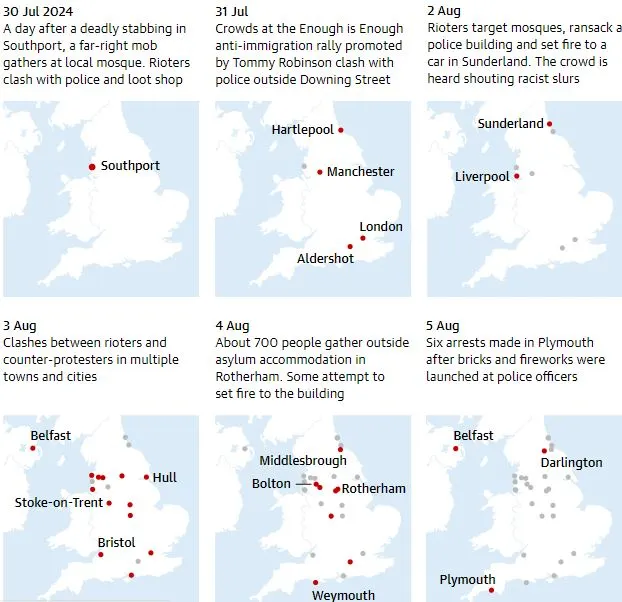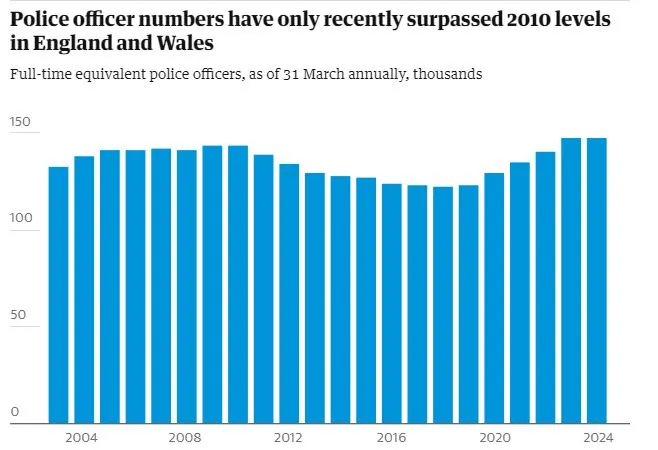The UK riots 2024 have shocked the nation with their intensity and scope. This recent wave of violence brings back memories of the 2011 London riots. The parallels are disturbing, with both events showcasing similar patterns of unrest and social upheaval. This article delves into the similarities and differences between the UK riots 2024 and the 2011 London riots, focusing on key aspects like the triggers, police response to riots, the role of disinformation and unrest, and the involvement of far-right violence.
The Spread and Scale of Violence
The 2011 London riots lasted for four days, starting as a small-scale disorder in Tottenham. It quickly spread across North London to Wood Green, involving hundreds of looters. By the third day, the unrest had affected 22 of the 32 London boroughs. Cities like Gloucester, Liverpool, Nottingham, and Birmingham also saw significant disturbances. Over 3,000 arrests were made, and the estimated costs exceeded £400 million.

Similarly, the UK riots 2024 began in the seaside town of Southport but rapidly spread to over a dozen towns and cities. Major cities like London, Manchester, Liverpool, and Birmingham witnessed violent clashes. However, the 2024 unrest also extended to smaller towns such as Hartlepool, Aldershot, and Middlesbrough. More than 400 arrests have been made so far, with the damage still being assessed.
The police response to riots in both instances involved large-scale deployments. In 2011, police described the disturbances as “unprecedented in the capital’s history.” The 2024 riots saw the deployment of an additional 2,200 riot-trained officers, bringing the total to nearly 4,000 officers on the ground. The intensity of the police response to riots highlights the serious nature of the unrest in both periods.
Triggers of the Riots
The 2011 London riots were triggered by the police shooting of Mark Duggan, a 29-year-old mixed-race British man. The police claimed Duggan was planning an armed attack and was in possession of an illegal firearm. However, Duggan’s family maintained he was unarmed and unlawfully killed. This incident sparked widespread anger and frustration with the police, leading to four days of intense rioting.
In contrast, the UK riots 2024 were triggered by the tragic stabbing of three young girls at a dance class in Southport. Axel Rudakubana, a 17-year-old born in Cardiff, has been charged with their murders. Before the suspect’s identity was confirmed, disinformation and unrest were fueled by false claims that a Muslim asylum seeker was responsible. This narrative, amplified by social media, played a significant role in mobilizing protests and subsequent violence.
Disinformation and unrest have been pivotal in both the 2011 and 2024 riots. In 2011, rumors spread via the BBM network, contributing to the chaos. In 2024, social media platforms like X (formerly Twitter) and Telegram amplified false claims about the identity of the attacker. These claims reached millions, influencing public perception and escalating tensions.
The Role of Disinformation
Disinformation has played a critical role in the UK riots 2024, much like it did in 2011. In 2011, false claims and rumors fueled the unrest. For instance, rumors about a girl being punched by police during a peaceful demonstration circulated widely. Similar disinformation tactics were observed in 2024. False claims that a Muslim asylum seeker was responsible for the Southport stabbings spread rapidly on social media. These false narratives were further amplified by far-right figures, exacerbating the violence.
The police response to riots in both periods involved combating disinformation. In 2011, police had to address rumors to prevent further escalation. In 2024, Merseyside police issued statements to correct false claims, including those spread by far-right activist Tommy Robinson. Despite these efforts, disinformation and unrest significantly influenced the scale and intensity of the riots.
Far-Right Involvement
Far-right violence has been a notable feature of the UK riots 2024. Unlike the 2011 London riots, which were primarily driven by socio-economic grievances, the 2024 unrest has seen significant involvement from far-right groups. These groups have used the riots to propagate racist, Islamophobic, and anti-immigration sentiments. The anti-fascism organization Hope Not Hate described the 2024 unrest as possibly “the worst wave of far-right violence in the UK postwar.”
The police response to riots involved addressing far-right violence. In 2011, the riots were not considered race riots, though they involved a diverse cross-section of communities. In 2024, however, far-right groups have actively targeted people based on their skin color, attacked mosques, and spread disinformation to incite violence.
Police Response to Riots

The police response to riots in 2011 involved deploying a significant number of officers. By the fourth day of the 2011 riots, the Metropolitan police had described the disturbances as unprecedented. More than 3,000 arrests were made across England, with over 2,000 people facing criminal charges. The courts operated 24 hours a day to process offenders, and magistrates were allowed to pass longer and tougher sentences.
In 2024, the police response to riots has been similarly robust. An extra 2,200 riot-trained officers have been deployed, bringing the total to nearly 4,000. However, the 2024 riots have highlighted an overcrowding crisis in prisons, complicating the justice system’s ability to process offenders. As of early August, the prison population in England and Wales was operating at over 99% capacity.

The justice minister, Heidi Alexander, announced measures to release thousands of inmates early to address the overcrowding crisis. This decision reflects the strained resources available to manage the large number of arrests related to the UK riots 2024. The government’s ability to handle the influx of offenders will be a crucial factor in restoring order and preventing further violence.
Political Responses
The political responses to the UK riots 2024 and the 2011 London riots have shown both similarities and differences. In 2011, Prime Minister David Cameron and Home Secretary Theresa May condemned the violence and established a panel to explore the causes of the disorder. They emphasized the need for law and order and promised that such violence would not be tolerated.
In 2024, Prime Minister Keir Starmer has taken a strong stance against the violence, particularly the involvement of far-right groups. He chaired an emergency meeting with police chiefs and ministers, announcing the assembly of a “standing army” of specialist police officers to combat the rioting. Starmer also emphasized the role of disinformation in fueling the unrest and vowed to hold those responsible accountable.
Home Secretary Yvette Cooper has introduced urgent measures to protect mosques and other vulnerable communities. The political response in 2024 has also involved addressing the role of social media in spreading disinformation. However, unlike in 2011, the current government faces the additional challenge of dealing with an overcrowded prison system.
Conclusion
The UK riots 2024 and the 2011 London riots share many disturbing similarities, yet they also have notable differences. Both events were marked by widespread violence, significant police response, and the critical role of disinformation and unrest. However, the 2024 riots have seen a more pronounced involvement of far-right violence and have occurred against the backdrop of an overcrowded prison system.
The police response to riots in both instances has involved large-scale deployments and efforts to combat disinformation. However, the current political and social landscape presents unique challenges for addressing the underlying causes of the unrest and preventing future violence. As the nation grapples with the aftermath of the UK riots 2024, it is crucial to learn from past events and implement measures to foster social cohesion and prevent such disturbances in the future.
Click here to read our latest article Exposing Federal Reserve Failures




